 ADDICTS
ADDICTSToxic Dream
Alessandro Mercuri __ June 08, 2012
About "L’IRREMPLAÇABLE EXPÉRIENCE DE L’EXPLOSION DE SMOBY"
(The irreplaceable experience of Smoby’s explosion)
SCULPTURE BY ANITA MOLINERO
<> PDF
« Let´s take, for example, this bit of wax which has just been taken from the beehive (…) and it happens that, while talking, one places it close to the fire: whatever flavour left evaporates, the smell vanishes, the colour changes, it loses its shape, its size increases, it liquefies, becoming hotter, one can hardly touch it, and despite being struck, it no longer emits any sound. Is it the same wax after this transformation? (…) Let´s consider it carefully, and excluding anything that does not belong to the wax, let´s see what is left. Surely there is only something that is extended, flexible and mutable. But what does that mean: flexible and mutable? »
René Descartes, Metaphysical Meditations, 1641
A pink fingered dawn rises over a landscape of rust and ruins. The action takes place in the northwest of Paris. Beyond the blind walls, old warehouses, peripheral industrial remains, at the Galerie Édouard Manet at Gennevilliers, Anita Molinero prepares an exhibition where the new sculptures of the series entitled « L’irremplaçable expérience de l’explosion de Smoby » will be shown.
The creation, manufacture and setting up of the works take place locally in the gallery´s backyard. Scattered on the floor are multiple detached parts. The artist´s assistants and collaborators busy themselves around these automobile entrails: steering column, steering wheel and suspensions, exhaust pipes and tubes. The used spare parts are remounted, checked then rearranged. Exhaust wheels, exhaust pipes, suspension crutches. Welding sparks, incandescent flames, light flashes, smoke spurting white flames.
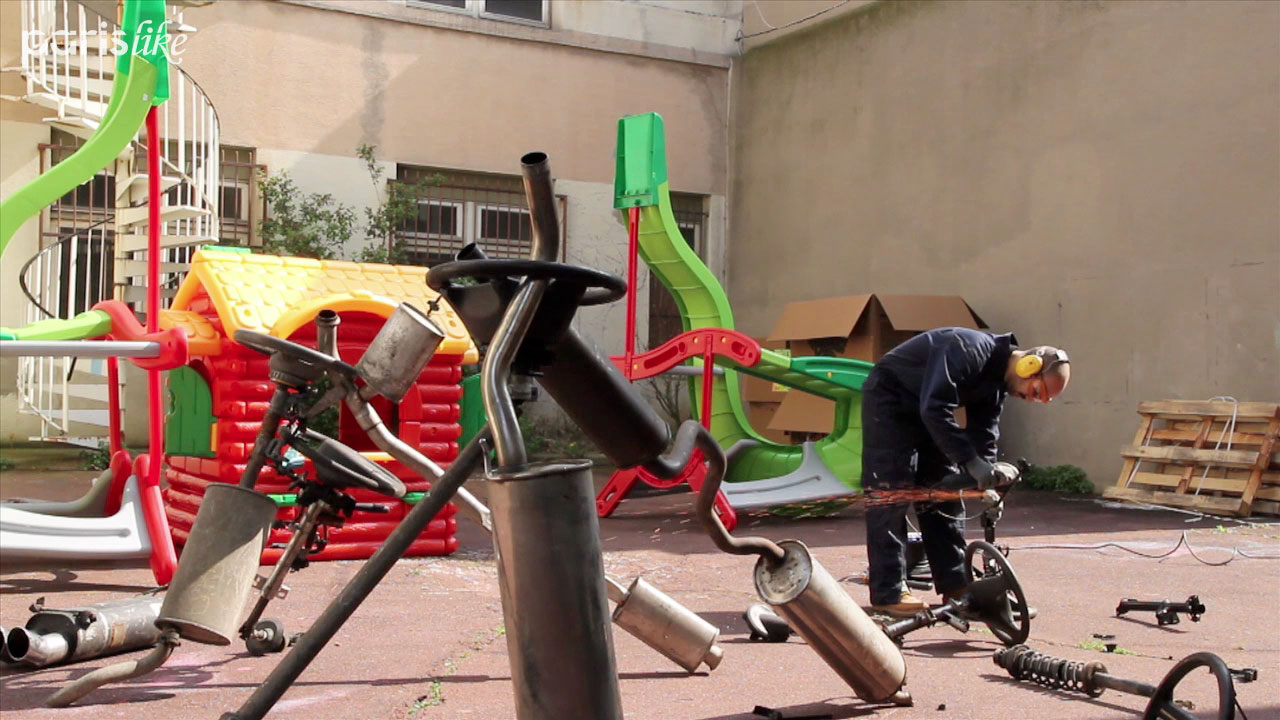
from the video "Toxic Dream"
At the newly created joints, the screws, the nuts, the bolts, once so harmless, so anodyne, almost evoke those issued from the deformed neck of an unnatural being: Frankenstein´s frightful creature. The mechanical skeleton regains life in renewed form, at once improbable, extraordinary and monstrous. The metallic tubes and pockets seem transformed into organs and vertebrae, elevated as on a pedestal. Perception becomes foggy and while escaping every explicit figuration, the whole undergoes an anthropomorphic transformation. One cannot help seeing in that mechanical reconstruction, in what stands « on its legs », a presence that is neither completely alive nor animalesque, neither is it simply industrial or technical: a hybrid presence. Anita Molinero states: « I don´t think out a project, but I visualise my work. I establish a balance of strengths. For this exhibition, I knew that I was going to work with exhaust pipes. And I said to myself that in the distortion of those tubes and in the orifices, one feels that there is gas, there are intestines. There goes the gas… passing. I have been wanting to do this for a long time, then I visualise an object. And at that moment, it takes on a shape that I had not necessarily foreseen. Then I forget everything. I turn around it. And between the visualisation and the juxtaposition of strengths, there is the actual verbalisation. If I don’t say to myself that there are gases passing through those tubes, distorting them like intestines and exiting in a vulgar way, malodorous even, at the end of those orifices, from those small tubes, I won´t feel like working with them. If I don’t tell myself that those headlights look like protruding eyes lighting up the night, I don’t feel like working with them… » The evocation seems to pursue in its own way the Lacanian enigma « One can see that to talk about the body is not, when in the realm of symbols, a metaphor ».

from the video "Toxic Dream"
In English, detached mechanical parts and organic parts of the body both bear the same name. They are both called « parts »: « auto parts » and « body parts ». The humid gastric intimacy is a mirror of the automobile entrails. Ancestral seat of the moods, bile which favours the digestion of fats, just like motor oil, may well be said to be yellow, proof of anxiety, or black, denoting a melancholic character. Through Anita Molinero´s tale, what takes part in the verbalisation has more to do with a poetic discourse than with a formalist statement, often flat, conventional, artistically correct. We are not dealing in this instance with anything « poetic » in the sense of an aesthetic category linked to a hypothetic science of beauty. It would sooner belong to a poetic dimension originating in poiêsis, understood as creation, action and doing (desire to work). Anita Molinero prefers « to tell herself » (if I don´t tell myself), allying the word and industrial animism, rather than talking according to the canon of an objectivist critical discourse.
In the improvised open air workshop, the artist´s assistants take off their anti-noise helmets, masks and goggles for welding to take on a more disquieting appearance. Their faces are now hidden behind gas masks. Now starts the work with fire that leads to the said « Irremplaçable expérience de l’explosion de Smoby ». Who is Smoby? What is his nature and what does his name stand for? A character out of a comic strip, a cartoon, onomatopoeia, a neologism? Industrially manufacturer, Smoby is a toy and plastic objects for children brand. A hand covered with a fire protective glove opens the tap of a gas carboy. A stream of fire burst forth from a blow torch in the direction of an innocent toy house in multi-coloured plastic.
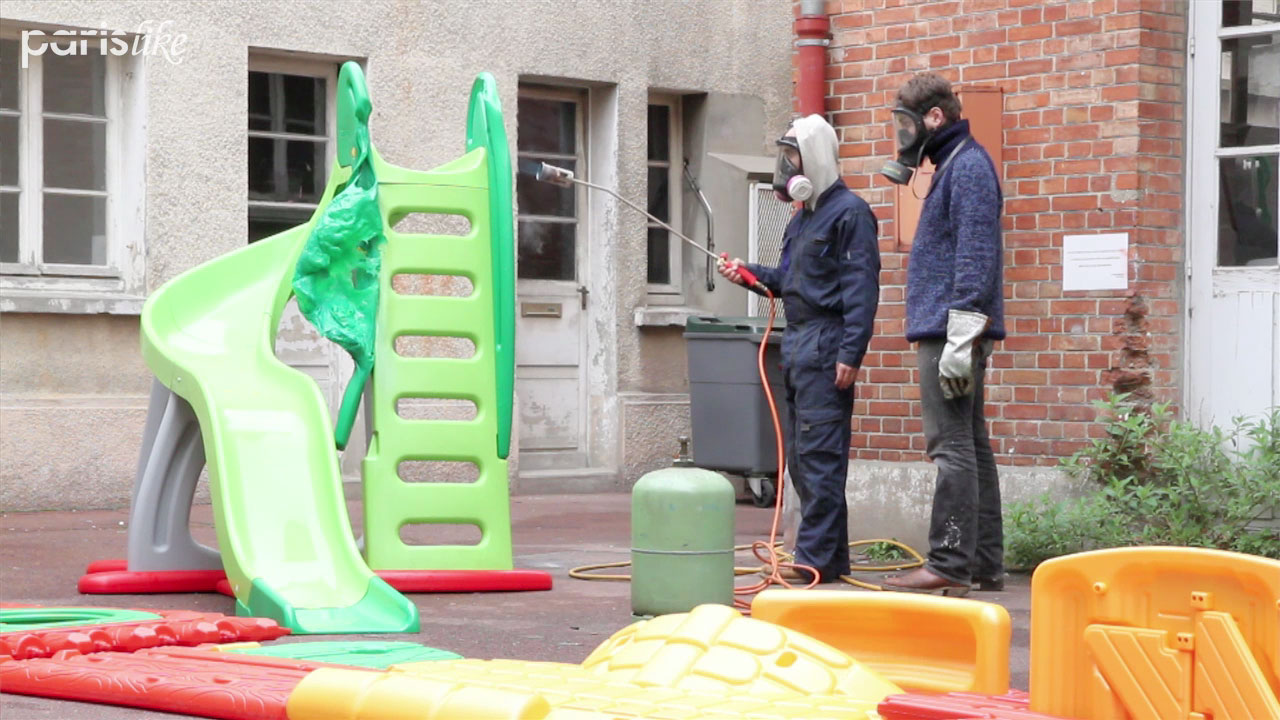
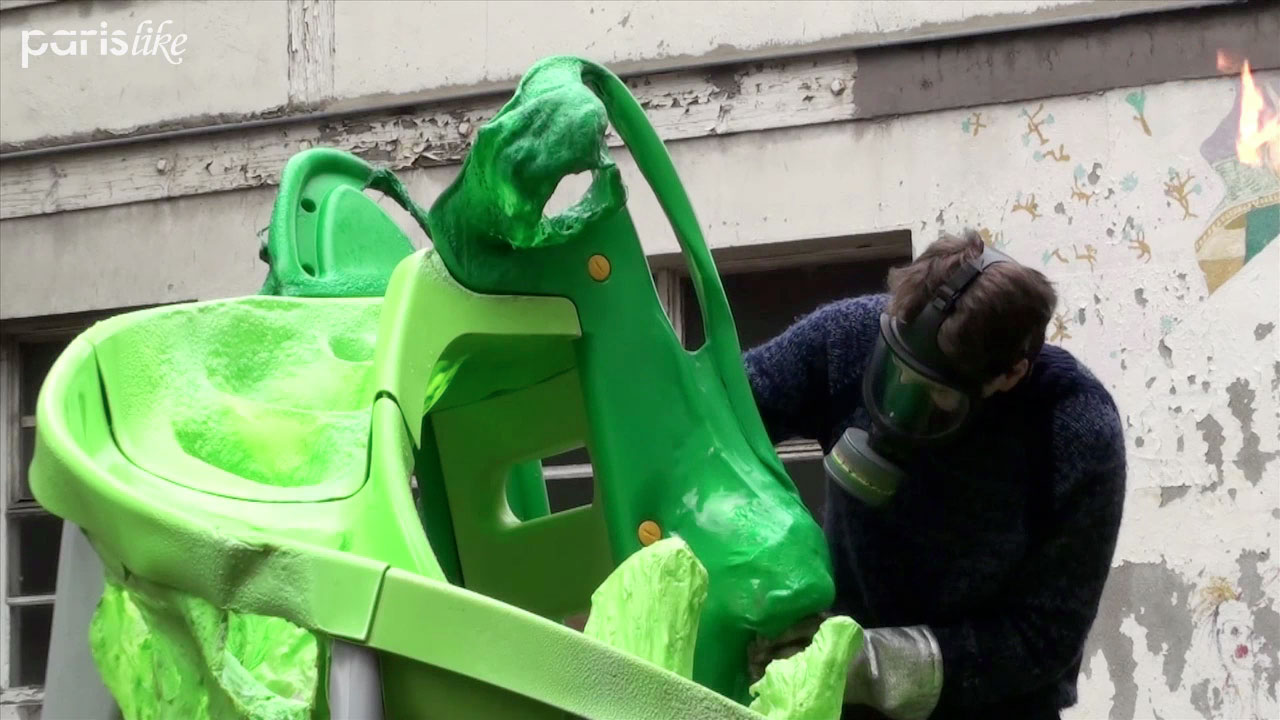
from the video "Toxic Dream"
The flames then lick a green slide whose structure slowly bends and then collapses. The moulded object looses its shape, transforms and discards its consistence. Like a green magma in fusion, the material punctures forming blisters, flowering. Bubbles and pustules germinate on its surface like monstrous and beautiful excrescences. The plastic returns to its primal un-differentiation, to its state of brute matter that flows, expands and overflows. But this transformation does not mean the passage from form to lack of form. Much more than questioning the nature of the object in its function, its form and its material state, the action of fire creates an impact on the eye of the beholder like a mirror of his spirit and calls for a phenomenology of perception.
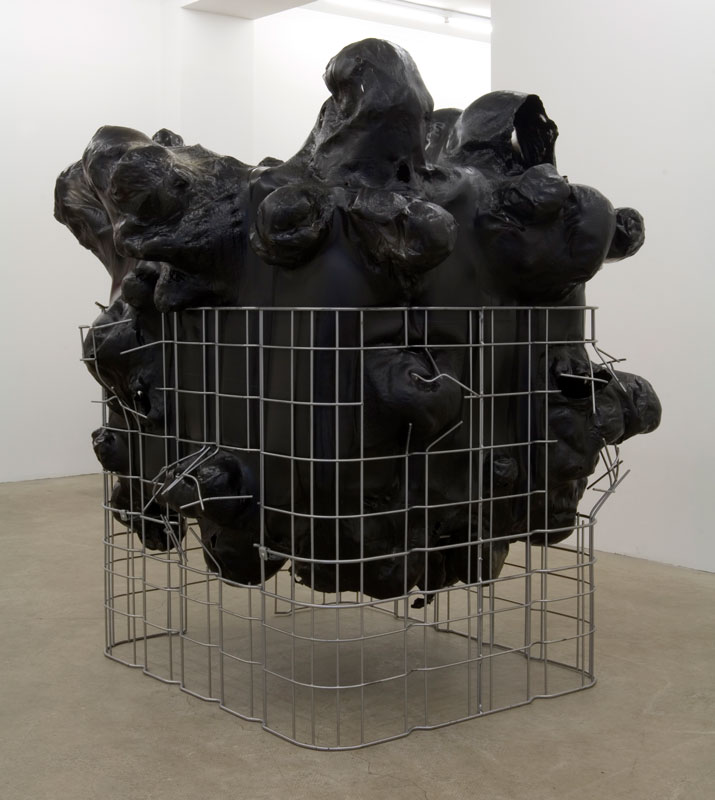
Exciterne, 2007, mixed media, 170 x 150 x 140 cm
There is a floating passage between the waking state and that of sleep, a twilight zone between wake and dream, a hypnotic state, in which consciousness on the threshold of sleep sees the object of thought alter, transform, its contours becoming blurred, deleted to the point of becoming unpronounceable, untouchable and hallucinatory. We are then confronted with an irreducible presence whose meaning one cannot fully grasp, for it is beyond or beneath meaning. On the threshold of sleep, this fragmentation of the retinal or mental perception – image or idea – is the field where forms and their inter-strength dynamic seems to express itself, meaning their plasticity, what takes on form and subsequently gives form. In the same way that the earth’s crust rests on a succession of magmatic layers, plastic or viscosity made of rock and metal in fusion, the part of our consciousness that has emerged and our perceptions seem to rest on a moving background of strange figures divorced from any kind of meaning. And those who have experienced it know: beyond the fear, the fear of dislocation, of obliteration and of burial, every earthquake, each seism is also a quake of meaning from whence the absurd springs up. On the surface of the planet and in the inner spirit, the effervescence of forms has the upper hand on the logic of meaning, energy prevails over concept. In that disturbance of perception, there occurs a loss of control. The object fixed by thought escapes, becomes mobile and transmuting. It becomes. It is transforming. In the same way, the plastic worked on by the sculptress, of inorganic appearance, becomes once again live matter and generates a tension between the telluric nature and the industrial aspect of the artefact. The viscous running of the plastic recalls the oil bearing origin of the material.

Ultime caillou, 2009, extruded polypropylene, polypropylene pallets,
déchets ultimes, 60 x 130 x 140 cm

Sans titre, 2009, tire-plastic
The sculpture has left the Stone Age to join that of the oil stone, the meeting point between petra (stone) and oleum (oil), petra-oleum, petrol. « Sometimes, I have the impression of working with what is becoming – and I play with the words fossil energies – but occasionally I say to myself, I am creating fossils for the future. » The deconstruction of a manufactured industrial product into a sculpture originates in an inversion of the production procedures. The act of destruction caused by fire is simultaneous with that of creation. As Anita Molinero states: « Naturally, I am challenged by the image and facile imagination imposed on children through these industrial objects that are so cold, so unreal, without texture or thickness. Of course, like everybody else, I find that stupid, but at the same time, when I start working with these objects, I try strangely to begin destroying certain images to create new ones. It is not in itself a gesture of destruction. I do not perform radical work, in the sense of going to the extreme of destruction, because simultaneous with the destruction of the object there is the discovery of its plasticity. It could be two gestures following each other as with the artists who are into denunciation, who destroy an icon to then reorganise and reconstruct it later. I have the impression that, simultaneously, I destroy, I transform and, in the same moment, I create, as you say, a vital impulse. Therefore, in my view, there is the art of a presence and of an incarnation rather than a «facilitation» that would be more like post-modern art (laughs), meaning it is more studied, more annotated and more thought out in both tempos. Through the gesture by which I burn, I deform, where the object melts I try in that simultaneity to fix the object in its movement and in doing that, it becomes a positive gesture of creation, almost joyous. »

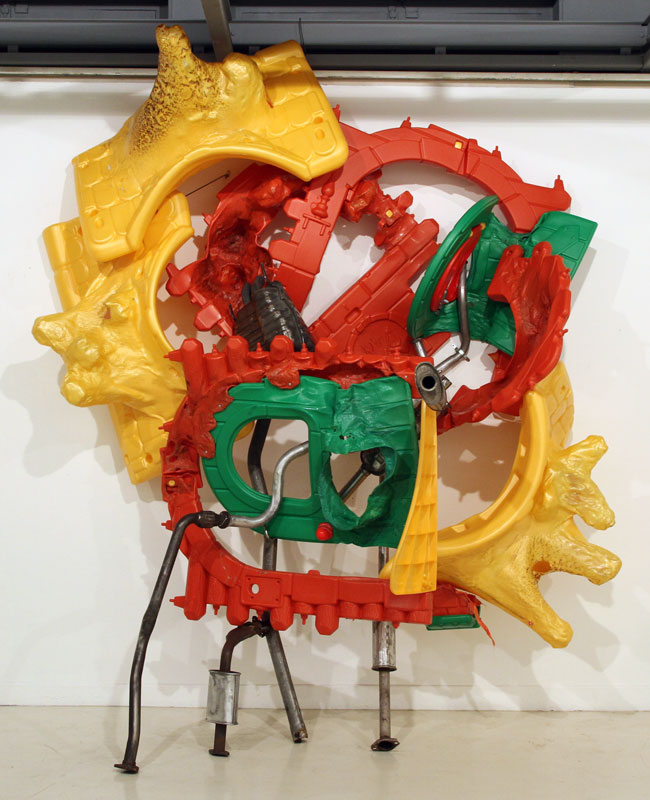
Sans titre, 2011, cabins for children, exhaust sytems,
283 x 278 x 170 cm et 300 x 260 x 144 cm
Three items newly created from « L’irremplaçable expérience de l’explosion de Smoby » are installed in the Édouard Manet Gallery in Gennevilliers. Two plastic slides sculpted by fire are mounted on their structure of metallic detached parts dominating the centre of the room. The relationship between what is on top to what is below, plastic on metal, is both heterogeneous thanks to the confrontation and the different nature of the materials and coherent thanks to the impression of a whole that it conveys. Something that is simultaneously violent, brutal and terrifying but also sensual, erotic, Dionysian. It is in a way as if the sculpture produced on the spectator an effect between a catharsis and an oxymoron, a union of contradictory meaning stretched between a kind of sublimated disgust and voluptuousness. Anita Molinero manages to fuse two antagonistic actions of creation-destruction resulting in a third entity which is the sculpture itself and which, like a chemical reaction, catalyses and throws the spectator into a joyous apocalypse, a sensorial universe endowed with a venomous vitality. The Dionysian dimension of the work underlies its hubris, its excessiveness, its inordinate overflowing of forms, its link to what is toxic and to intoxication. But another divinity may well be summoned, Hephaestus, or Vulcan to the Romans, the God of fire, ironworks, metals as well as terrestrial or submarine volcanoes. A hard working divinity, almost a metallurgist. One of the first sculptures mentioned in the West, though fictional, is described by Homer in the Iliad. It regards Achilles’ shield fashioned by the god of forges on the anvil with the help of a hammer and tongs, then finely chiselled with extraordinary scenes in low relief representing marriages and feasts, sacrifices and labours, noises and furies. Homer describes them vividly, like a tableau vivant. The shield-sculpture incarnates the birth of representation as visual narrative. The first sculpture is, therefore, a bronze weapon. Art and war, representation and destruction go hand in hand, one serving as support to the other. And it is armed with his « most splendid armour than the splendour of fire » manufactured by Hephaestus, that the earth was covered with « dew tinted with blood » and that Achilles terrified his enemies: « And the point of his spear pierced him to his navel, and he fell, screaming, on his knees; and a black cloud enveloped him, while bent down on the earth, he held back his entrails with his hands. » Today, to the age of bronze replies the age of the atom. 2800 years after Homer and 15 years after Hiroshima, Yves Klein creates his first anthropometries, inspired he says, by his discovery of the imprint of bodies left on the walls on the occasion of the nuclear explosion in 1945. Terrible or obscene irony, the uranium bomb is nicknamed with the infantile name of « Little Boy ». After Palaeolithic art showing rupestrian imprints of hands, humanity discovers atomic mural traces. The horror-apocalypse questions the status of the visible and the invisible. To the unrepresentability of the Shoah responds the extreme figuration of radiating traces. Yet, in both cases, the terminology addresses fire: atomic with the projection of a burning breath and holocaust designating a sacrifice after immolation. The impression of destruction and desolation, the feeling of finitude and menace, irrigate the sculptures by Anita Molinero.

Exhibition view, CAPC Bordeaux, 2010, polystyrene plates, various dimensions
But paradoxically, the brutality and the darkness of the creative gesture reveal nothing morbid or « deadly », because her work does not participate in denunciation or any other therapeutic effect. Therefore, we can confront the dribbling of resin, César’s expansions mirrored in the sculptor’s plastic discharges. Anita Molinero opposes what she calls the fountain energy of the industrial heyday, which has now run dry, to contemporary industrial dismemberment. The pop fascination has now made way for another way of looking. « César contemplates living and flowing, marvelling at that new primal matter, whereas I find myself in a dismembered, disjointed industry … and so I work on the industrial residues, that have nothing to do with waste in the pathetic sense of the term. » From the prior works dated from the mid 1980s to the 1990s, constituted and designated as cardboards, foams, plastics, polystyrenes up to the recent monumental sets, there persists a pronounced taste for building materials, for debris, detritus, rubbish and their contents, rubbish bags, bins and containers.
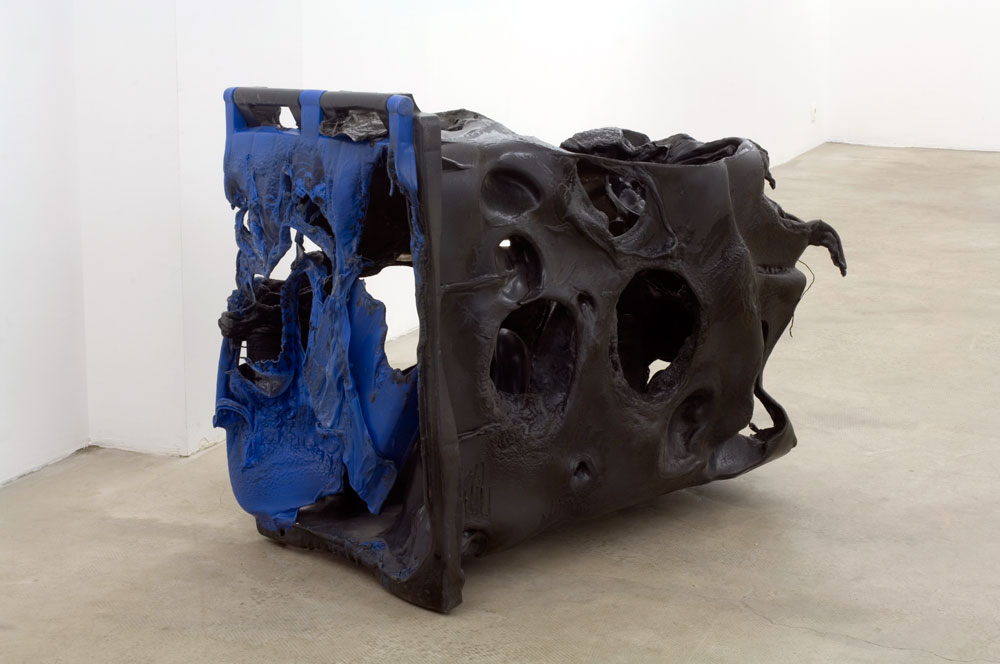
Sans titre, 2003
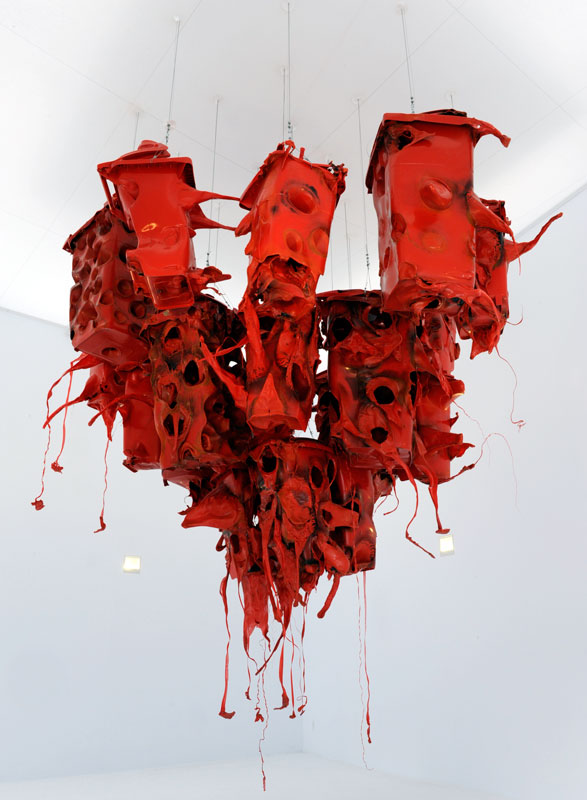
Sans titre, 2005 - from la Force de l'Art02, 2009, melted PVC bins
« I refused to call that sculpture. So I refused to give it a name. And it not easy to make a nameless object. People came to the workshop, nobody understood quite where was the debris of the sculpture or was it sculpture as debris (…) And that is why I say that it is an act that has truly failed. That is why my sculpture is flamboyant, because it is composed solely of failures as far as sculpture is concerned. »

série Les cartons, 1984-92

sac en skaï, 1991, foam rubber, 40 x 20 cm
Though they carry strong connotations, these « poor » materials employed cannot be reduced to simple significators of meaning or rhetorical effects. It is one of the strengths of her work that it favours the signifier, the plastic reality of materials as such, asserting the primacy of the sensitive experience over just the critical or ideological discourse. Anita Molinero’s creations do not aim at a simple ecological awareness before generalised industrial pollution, unlimited, of the lands, the seas and the air, luminous pollution of the night and spatial pollution in orbit. Neither complaint nor lament. There is no nihilism in all that, as if seen from afar everything flowed away, from plastic dribbling to those of the earth itself. As if the earth has become a plastic planet, with a polystyrene terrestrial crust, flowing in a black tide, like a ship that rats had abandoned long ago and that floundered in darkness. « I do not belong to that group of artists who are into denunciation. Strangely though, I believe I am an artist who is concerned with our times, very concerned, and I think some of the challenges are close to me. But, I believe that when we realised we were all in the immersion, we cannot begin putting a moral distance, by saying well consumerism is … It is not possible for an artist, we are too involved, we produce too many objects ourselves, to venture once again along that path of denunciation. I know the world in which I live. I work with the conditions of that very world, I do not work against it, I metaphorise our era. »
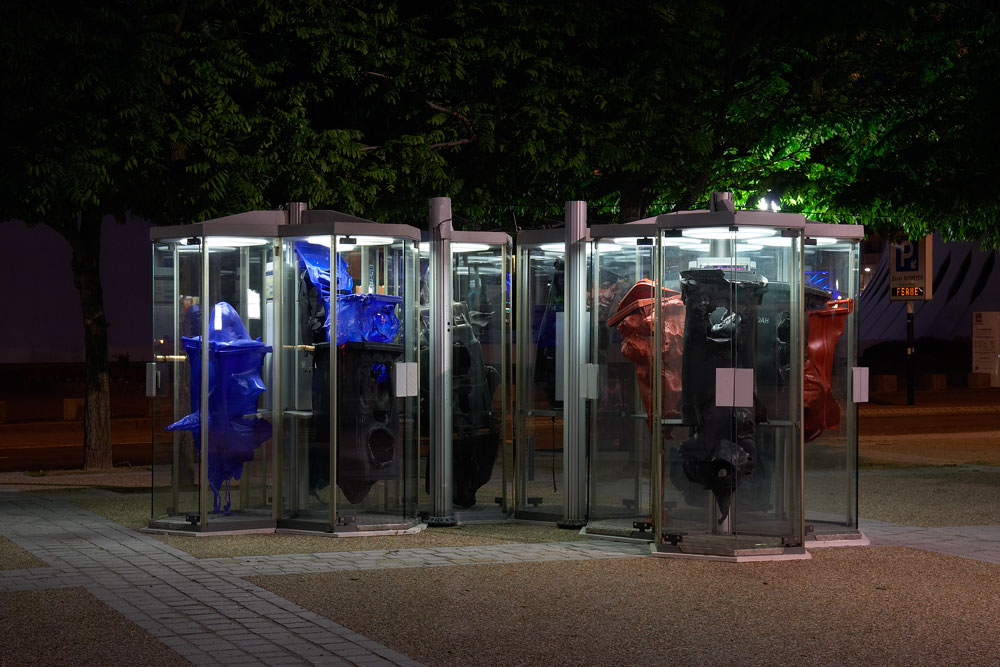
Rendez-vous !, 2008, phone booths and melted containers
Contrary to denunciation and critical discourse, to the « rhetorical effect » it produces, the expression « sculpture of the effect », used by Anita Molinero, could underline the spectacular and sensualist dimension that it radiates. The term effect remits to the special effects in the cinema, as they were reinvented at the narrative and plastic levels by the film T2, Terminator 2 : The Last Judgement (1991). The image of synthesis produces in it a new perception regime, that of the dilated pupil undergoing morphing, that of a protean cyborg, a creature made of artificial flesh, metal, cables and bits. Therefore, this hybrid being is a chameleon, capable of every metamorphosis, from inorganic to organic, from metal to animal, from solid to liquid. Incidentally, the mimetic multi-combination of the Terminator, allowing it to change morphology, though fictional in the XXth century is about to become a reality in the XXIth century thanks to the latest developments in SMA metallurgy: shape-memory alloy. Without being neither a pop artist, nor a neo this, or post that, Anita Molinero does not hide her interest for the categories of trash, cheap, junk and pulp.
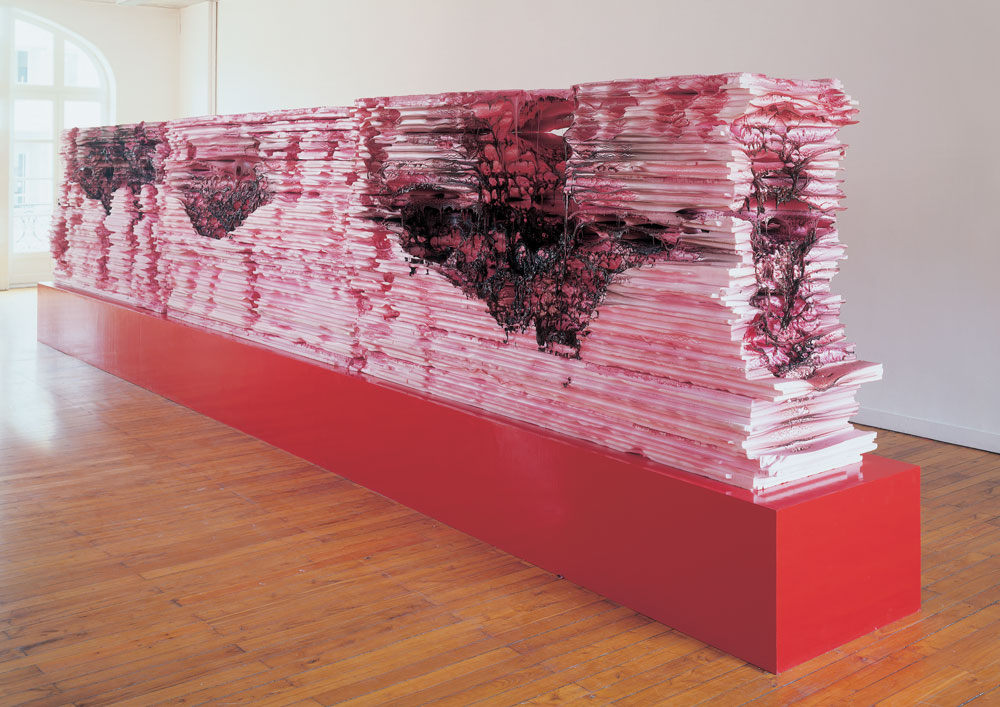
Sans titre (La rose), 2003, pink extruded polystyrene plates melted with acetone
Captivating and spectacular, the sculpted work of Anita Molinero proposed a sensitive and sensorial experience taken from synaesthesia. The shapes, textures, volumes combine with a great chromatic richness inherent to the nature of the materials. The colour is intrinsic to the objects used: the rubbish bins can be blood red, fluorescent yellow, green or bi-coloured orange and grey. The polystyrenes are candy pink and dark crimson and caramel; the plastic bags are off-white, the truck tires a deep black, striped building site pins, multicoloured car headlights and the small of molten plastic, real or imaginary. The perception of the onlooker oscillates simultaneously between the figurative part played by the object and the abstraction generated by the action of fire. The hallucinatory gaze, mesmerised, loses itself in the piling up, bursting, concretion, folding and unfolding, petrification, stratification or layering effects. The toxic and unctuous mingle. Opposites fuse such as gluttony and unpalatability. Like in a tragi-comic play, sensations mix without excluding each other. Monstrous inflatable doll extruded.
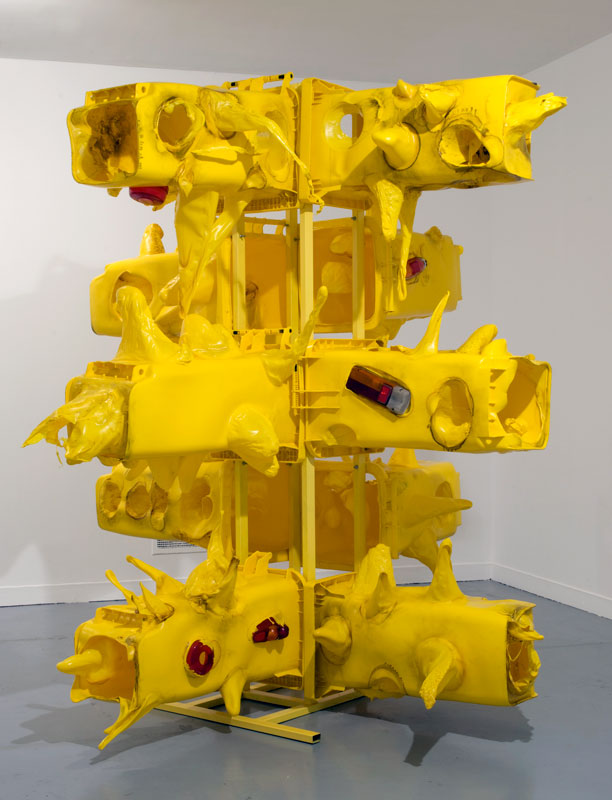
Sans titre, 2005, plastic bins, metal structure, car headlights
Something that is brutal and playful, grotesque and excessive, shows itself to be seen and touched. Plastic throats, generous curves, turgescences, excrescences plunge us into a state of libidinal stupor, macabre or infantile, where the erotic explosion becomes indistinguishable from the pulsation of death. And Anita Molinero burst out laughing: « In fact, from a magnificent cloud comes evil … Chernobyl… I became aware of it thanks to the clouds. Awareness that danger could go unnoticed. Until then, we imagined that our enemy was visible. He stood in front of us, behind us, caught us unaware, but he was visible. And we could, in any case, confine it in territories. Slowly, I realised that a new form materialised, toxic, carried by a cloud; a powerful artistic and poetic symbol. For once, something that we could not grasp yet was not mystical. Something invisible that reached us and that was completely disturbing, that for me at least upset all artistic data. We were going to have to lug it around with us. I did not know how. Little by little it transported itself onto material substances, their danger. And I realised that in two, three years my work changed. Something came about that was going to really complicate our lives. Chernobyl reinforced the fact that there were no frontiers, that the world was global. There was also the fact that the one who had been contaminated could keep his outward appearance intact, while the interior was perhaps going to disintegrate. With Chernobyl, no one was on the right side. Perhaps there is violence and a cruelty in the artistic act in that we grab and go for these collective tragedies to integrate them into our work, into our very lives… I said to myself, this is crazy, fascinating, everything is upside down… Where are our enemies? What about those political threats with the Twin Towers! Where are they, these enemies of ours? How did they get there? No war was declared. Are wars still declared – I wondered? Not sure. Those types of war are very recent. They just occur. They happen. »
Translated from the French by Juan 2santos Publishing
Quotes and conversation with Anita Molinero
taken from the video « Toxic Dream »
Images by Haijun Park & all rights reserved
Courtesy Galerie Alain Gutharc
(The irreplaceable experience of Smoby’s explosion)
SCULPTURE BY ANITA MOLINERO
« Let´s take, for example, this bit of wax which has just been taken from the beehive (…) and it happens that, while talking, one places it close to the fire: whatever flavour left evaporates, the smell vanishes, the colour changes, it loses its shape, its size increases, it liquefies, becoming hotter, one can hardly touch it, and despite being struck, it no longer emits any sound. Is it the same wax after this transformation? (…) Let´s consider it carefully, and excluding anything that does not belong to the wax, let´s see what is left. Surely there is only something that is extended, flexible and mutable. But what does that mean: flexible and mutable? »
René Descartes, Metaphysical Meditations, 1641
A pink fingered dawn rises over a landscape of rust and ruins. The action takes place in the northwest of Paris. Beyond the blind walls, old warehouses, peripheral industrial remains, at the Galerie Édouard Manet at Gennevilliers, Anita Molinero prepares an exhibition where the new sculptures of the series entitled « L’irremplaçable expérience de l’explosion de Smoby » will be shown.
The creation, manufacture and setting up of the works take place locally in the gallery´s backyard. Scattered on the floor are multiple detached parts. The artist´s assistants and collaborators busy themselves around these automobile entrails: steering column, steering wheel and suspensions, exhaust pipes and tubes. The used spare parts are remounted, checked then rearranged. Exhaust wheels, exhaust pipes, suspension crutches. Welding sparks, incandescent flames, light flashes, smoke spurting white flames.

from the video "Toxic Dream"
At the newly created joints, the screws, the nuts, the bolts, once so harmless, so anodyne, almost evoke those issued from the deformed neck of an unnatural being: Frankenstein´s frightful creature. The mechanical skeleton regains life in renewed form, at once improbable, extraordinary and monstrous. The metallic tubes and pockets seem transformed into organs and vertebrae, elevated as on a pedestal. Perception becomes foggy and while escaping every explicit figuration, the whole undergoes an anthropomorphic transformation. One cannot help seeing in that mechanical reconstruction, in what stands « on its legs », a presence that is neither completely alive nor animalesque, neither is it simply industrial or technical: a hybrid presence. Anita Molinero states: « I don´t think out a project, but I visualise my work. I establish a balance of strengths. For this exhibition, I knew that I was going to work with exhaust pipes. And I said to myself that in the distortion of those tubes and in the orifices, one feels that there is gas, there are intestines. There goes the gas… passing. I have been wanting to do this for a long time, then I visualise an object. And at that moment, it takes on a shape that I had not necessarily foreseen. Then I forget everything. I turn around it. And between the visualisation and the juxtaposition of strengths, there is the actual verbalisation. If I don’t say to myself that there are gases passing through those tubes, distorting them like intestines and exiting in a vulgar way, malodorous even, at the end of those orifices, from those small tubes, I won´t feel like working with them. If I don’t tell myself that those headlights look like protruding eyes lighting up the night, I don’t feel like working with them… » The evocation seems to pursue in its own way the Lacanian enigma « One can see that to talk about the body is not, when in the realm of symbols, a metaphor ».

from the video "Toxic Dream"
In English, detached mechanical parts and organic parts of the body both bear the same name. They are both called « parts »: « auto parts » and « body parts ». The humid gastric intimacy is a mirror of the automobile entrails. Ancestral seat of the moods, bile which favours the digestion of fats, just like motor oil, may well be said to be yellow, proof of anxiety, or black, denoting a melancholic character. Through Anita Molinero´s tale, what takes part in the verbalisation has more to do with a poetic discourse than with a formalist statement, often flat, conventional, artistically correct. We are not dealing in this instance with anything « poetic » in the sense of an aesthetic category linked to a hypothetic science of beauty. It would sooner belong to a poetic dimension originating in poiêsis, understood as creation, action and doing (desire to work). Anita Molinero prefers « to tell herself » (if I don´t tell myself), allying the word and industrial animism, rather than talking according to the canon of an objectivist critical discourse.
In the improvised open air workshop, the artist´s assistants take off their anti-noise helmets, masks and goggles for welding to take on a more disquieting appearance. Their faces are now hidden behind gas masks. Now starts the work with fire that leads to the said « Irremplaçable expérience de l’explosion de Smoby ». Who is Smoby? What is his nature and what does his name stand for? A character out of a comic strip, a cartoon, onomatopoeia, a neologism? Industrially manufacturer, Smoby is a toy and plastic objects for children brand. A hand covered with a fire protective glove opens the tap of a gas carboy. A stream of fire burst forth from a blow torch in the direction of an innocent toy house in multi-coloured plastic.


from the video "Toxic Dream"
The flames then lick a green slide whose structure slowly bends and then collapses. The moulded object looses its shape, transforms and discards its consistence. Like a green magma in fusion, the material punctures forming blisters, flowering. Bubbles and pustules germinate on its surface like monstrous and beautiful excrescences. The plastic returns to its primal un-differentiation, to its state of brute matter that flows, expands and overflows. But this transformation does not mean the passage from form to lack of form. Much more than questioning the nature of the object in its function, its form and its material state, the action of fire creates an impact on the eye of the beholder like a mirror of his spirit and calls for a phenomenology of perception.

Exciterne, 2007, mixed media, 170 x 150 x 140 cm
There is a floating passage between the waking state and that of sleep, a twilight zone between wake and dream, a hypnotic state, in which consciousness on the threshold of sleep sees the object of thought alter, transform, its contours becoming blurred, deleted to the point of becoming unpronounceable, untouchable and hallucinatory. We are then confronted with an irreducible presence whose meaning one cannot fully grasp, for it is beyond or beneath meaning. On the threshold of sleep, this fragmentation of the retinal or mental perception – image or idea – is the field where forms and their inter-strength dynamic seems to express itself, meaning their plasticity, what takes on form and subsequently gives form. In the same way that the earth’s crust rests on a succession of magmatic layers, plastic or viscosity made of rock and metal in fusion, the part of our consciousness that has emerged and our perceptions seem to rest on a moving background of strange figures divorced from any kind of meaning. And those who have experienced it know: beyond the fear, the fear of dislocation, of obliteration and of burial, every earthquake, each seism is also a quake of meaning from whence the absurd springs up. On the surface of the planet and in the inner spirit, the effervescence of forms has the upper hand on the logic of meaning, energy prevails over concept. In that disturbance of perception, there occurs a loss of control. The object fixed by thought escapes, becomes mobile and transmuting. It becomes. It is transforming. In the same way, the plastic worked on by the sculptress, of inorganic appearance, becomes once again live matter and generates a tension between the telluric nature and the industrial aspect of the artefact. The viscous running of the plastic recalls the oil bearing origin of the material.

Ultime caillou, 2009, extruded polypropylene, polypropylene pallets,
déchets ultimes, 60 x 130 x 140 cm

Sans titre, 2009, tire-plastic
The sculpture has left the Stone Age to join that of the oil stone, the meeting point between petra (stone) and oleum (oil), petra-oleum, petrol. « Sometimes, I have the impression of working with what is becoming – and I play with the words fossil energies – but occasionally I say to myself, I am creating fossils for the future. » The deconstruction of a manufactured industrial product into a sculpture originates in an inversion of the production procedures. The act of destruction caused by fire is simultaneous with that of creation. As Anita Molinero states: « Naturally, I am challenged by the image and facile imagination imposed on children through these industrial objects that are so cold, so unreal, without texture or thickness. Of course, like everybody else, I find that stupid, but at the same time, when I start working with these objects, I try strangely to begin destroying certain images to create new ones. It is not in itself a gesture of destruction. I do not perform radical work, in the sense of going to the extreme of destruction, because simultaneous with the destruction of the object there is the discovery of its plasticity. It could be two gestures following each other as with the artists who are into denunciation, who destroy an icon to then reorganise and reconstruct it later. I have the impression that, simultaneously, I destroy, I transform and, in the same moment, I create, as you say, a vital impulse. Therefore, in my view, there is the art of a presence and of an incarnation rather than a «facilitation» that would be more like post-modern art (laughs), meaning it is more studied, more annotated and more thought out in both tempos. Through the gesture by which I burn, I deform, where the object melts I try in that simultaneity to fix the object in its movement and in doing that, it becomes a positive gesture of creation, almost joyous. »


Sans titre, 2011, cabins for children, exhaust sytems,
283 x 278 x 170 cm et 300 x 260 x 144 cm
Three items newly created from « L’irremplaçable expérience de l’explosion de Smoby » are installed in the Édouard Manet Gallery in Gennevilliers. Two plastic slides sculpted by fire are mounted on their structure of metallic detached parts dominating the centre of the room. The relationship between what is on top to what is below, plastic on metal, is both heterogeneous thanks to the confrontation and the different nature of the materials and coherent thanks to the impression of a whole that it conveys. Something that is simultaneously violent, brutal and terrifying but also sensual, erotic, Dionysian. It is in a way as if the sculpture produced on the spectator an effect between a catharsis and an oxymoron, a union of contradictory meaning stretched between a kind of sublimated disgust and voluptuousness. Anita Molinero manages to fuse two antagonistic actions of creation-destruction resulting in a third entity which is the sculpture itself and which, like a chemical reaction, catalyses and throws the spectator into a joyous apocalypse, a sensorial universe endowed with a venomous vitality. The Dionysian dimension of the work underlies its hubris, its excessiveness, its inordinate overflowing of forms, its link to what is toxic and to intoxication. But another divinity may well be summoned, Hephaestus, or Vulcan to the Romans, the God of fire, ironworks, metals as well as terrestrial or submarine volcanoes. A hard working divinity, almost a metallurgist. One of the first sculptures mentioned in the West, though fictional, is described by Homer in the Iliad. It regards Achilles’ shield fashioned by the god of forges on the anvil with the help of a hammer and tongs, then finely chiselled with extraordinary scenes in low relief representing marriages and feasts, sacrifices and labours, noises and furies. Homer describes them vividly, like a tableau vivant. The shield-sculpture incarnates the birth of representation as visual narrative. The first sculpture is, therefore, a bronze weapon. Art and war, representation and destruction go hand in hand, one serving as support to the other. And it is armed with his « most splendid armour than the splendour of fire » manufactured by Hephaestus, that the earth was covered with « dew tinted with blood » and that Achilles terrified his enemies: « And the point of his spear pierced him to his navel, and he fell, screaming, on his knees; and a black cloud enveloped him, while bent down on the earth, he held back his entrails with his hands. » Today, to the age of bronze replies the age of the atom. 2800 years after Homer and 15 years after Hiroshima, Yves Klein creates his first anthropometries, inspired he says, by his discovery of the imprint of bodies left on the walls on the occasion of the nuclear explosion in 1945. Terrible or obscene irony, the uranium bomb is nicknamed with the infantile name of « Little Boy ». After Palaeolithic art showing rupestrian imprints of hands, humanity discovers atomic mural traces. The horror-apocalypse questions the status of the visible and the invisible. To the unrepresentability of the Shoah responds the extreme figuration of radiating traces. Yet, in both cases, the terminology addresses fire: atomic with the projection of a burning breath and holocaust designating a sacrifice after immolation. The impression of destruction and desolation, the feeling of finitude and menace, irrigate the sculptures by Anita Molinero.

Exhibition view, CAPC Bordeaux, 2010, polystyrene plates, various dimensions
But paradoxically, the brutality and the darkness of the creative gesture reveal nothing morbid or « deadly », because her work does not participate in denunciation or any other therapeutic effect. Therefore, we can confront the dribbling of resin, César’s expansions mirrored in the sculptor’s plastic discharges. Anita Molinero opposes what she calls the fountain energy of the industrial heyday, which has now run dry, to contemporary industrial dismemberment. The pop fascination has now made way for another way of looking. « César contemplates living and flowing, marvelling at that new primal matter, whereas I find myself in a dismembered, disjointed industry … and so I work on the industrial residues, that have nothing to do with waste in the pathetic sense of the term. » From the prior works dated from the mid 1980s to the 1990s, constituted and designated as cardboards, foams, plastics, polystyrenes up to the recent monumental sets, there persists a pronounced taste for building materials, for debris, detritus, rubbish and their contents, rubbish bags, bins and containers.

Sans titre, 2003

Sans titre, 2005 - from la Force de l'Art02, 2009, melted PVC bins
« I refused to call that sculpture. So I refused to give it a name. And it not easy to make a nameless object. People came to the workshop, nobody understood quite where was the debris of the sculpture or was it sculpture as debris (…) And that is why I say that it is an act that has truly failed. That is why my sculpture is flamboyant, because it is composed solely of failures as far as sculpture is concerned. »

série Les cartons, 1984-92

sac en skaï, 1991, foam rubber, 40 x 20 cm
Though they carry strong connotations, these « poor » materials employed cannot be reduced to simple significators of meaning or rhetorical effects. It is one of the strengths of her work that it favours the signifier, the plastic reality of materials as such, asserting the primacy of the sensitive experience over just the critical or ideological discourse. Anita Molinero’s creations do not aim at a simple ecological awareness before generalised industrial pollution, unlimited, of the lands, the seas and the air, luminous pollution of the night and spatial pollution in orbit. Neither complaint nor lament. There is no nihilism in all that, as if seen from afar everything flowed away, from plastic dribbling to those of the earth itself. As if the earth has become a plastic planet, with a polystyrene terrestrial crust, flowing in a black tide, like a ship that rats had abandoned long ago and that floundered in darkness. « I do not belong to that group of artists who are into denunciation. Strangely though, I believe I am an artist who is concerned with our times, very concerned, and I think some of the challenges are close to me. But, I believe that when we realised we were all in the immersion, we cannot begin putting a moral distance, by saying well consumerism is … It is not possible for an artist, we are too involved, we produce too many objects ourselves, to venture once again along that path of denunciation. I know the world in which I live. I work with the conditions of that very world, I do not work against it, I metaphorise our era. »

Rendez-vous !, 2008, phone booths and melted containers
Contrary to denunciation and critical discourse, to the « rhetorical effect » it produces, the expression « sculpture of the effect », used by Anita Molinero, could underline the spectacular and sensualist dimension that it radiates. The term effect remits to the special effects in the cinema, as they were reinvented at the narrative and plastic levels by the film T2, Terminator 2 : The Last Judgement (1991). The image of synthesis produces in it a new perception regime, that of the dilated pupil undergoing morphing, that of a protean cyborg, a creature made of artificial flesh, metal, cables and bits. Therefore, this hybrid being is a chameleon, capable of every metamorphosis, from inorganic to organic, from metal to animal, from solid to liquid. Incidentally, the mimetic multi-combination of the Terminator, allowing it to change morphology, though fictional in the XXth century is about to become a reality in the XXIth century thanks to the latest developments in SMA metallurgy: shape-memory alloy. Without being neither a pop artist, nor a neo this, or post that, Anita Molinero does not hide her interest for the categories of trash, cheap, junk and pulp.

Sans titre (La rose), 2003, pink extruded polystyrene plates melted with acetone
Captivating and spectacular, the sculpted work of Anita Molinero proposed a sensitive and sensorial experience taken from synaesthesia. The shapes, textures, volumes combine with a great chromatic richness inherent to the nature of the materials. The colour is intrinsic to the objects used: the rubbish bins can be blood red, fluorescent yellow, green or bi-coloured orange and grey. The polystyrenes are candy pink and dark crimson and caramel; the plastic bags are off-white, the truck tires a deep black, striped building site pins, multicoloured car headlights and the small of molten plastic, real or imaginary. The perception of the onlooker oscillates simultaneously between the figurative part played by the object and the abstraction generated by the action of fire. The hallucinatory gaze, mesmerised, loses itself in the piling up, bursting, concretion, folding and unfolding, petrification, stratification or layering effects. The toxic and unctuous mingle. Opposites fuse such as gluttony and unpalatability. Like in a tragi-comic play, sensations mix without excluding each other. Monstrous inflatable doll extruded.

Sans titre, 2005, plastic bins, metal structure, car headlights
Something that is brutal and playful, grotesque and excessive, shows itself to be seen and touched. Plastic throats, generous curves, turgescences, excrescences plunge us into a state of libidinal stupor, macabre or infantile, where the erotic explosion becomes indistinguishable from the pulsation of death. And Anita Molinero burst out laughing: « In fact, from a magnificent cloud comes evil … Chernobyl… I became aware of it thanks to the clouds. Awareness that danger could go unnoticed. Until then, we imagined that our enemy was visible. He stood in front of us, behind us, caught us unaware, but he was visible. And we could, in any case, confine it in territories. Slowly, I realised that a new form materialised, toxic, carried by a cloud; a powerful artistic and poetic symbol. For once, something that we could not grasp yet was not mystical. Something invisible that reached us and that was completely disturbing, that for me at least upset all artistic data. We were going to have to lug it around with us. I did not know how. Little by little it transported itself onto material substances, their danger. And I realised that in two, three years my work changed. Something came about that was going to really complicate our lives. Chernobyl reinforced the fact that there were no frontiers, that the world was global. There was also the fact that the one who had been contaminated could keep his outward appearance intact, while the interior was perhaps going to disintegrate. With Chernobyl, no one was on the right side. Perhaps there is violence and a cruelty in the artistic act in that we grab and go for these collective tragedies to integrate them into our work, into our very lives… I said to myself, this is crazy, fascinating, everything is upside down… Where are our enemies? What about those political threats with the Twin Towers! Where are they, these enemies of ours? How did they get there? No war was declared. Are wars still declared – I wondered? Not sure. Those types of war are very recent. They just occur. They happen. »
Translated from the French by Juan 2santos Publishing
Quotes and conversation with Anita Molinero
taken from the video « Toxic Dream »
Images by Haijun Park & all rights reserved
Courtesy Galerie Alain Gutharc
TAGS : Anita Molinero, Toxic Dream, L’irremplaçable expérience de l’explosion de Smoby, The irreplaceable experience of Smoby’s explosion, Galerie Alain Gutharc, Galerie Édouard Manet of Gennevilliers, sculpture, extruded polypropylene, plastic, tire, cabin for children, exhaust sytem, trash bin, container
NEXT POST >>










